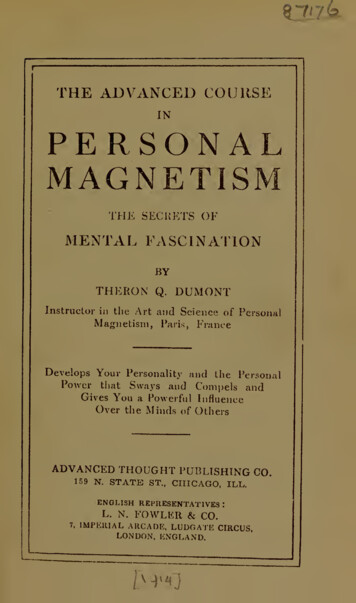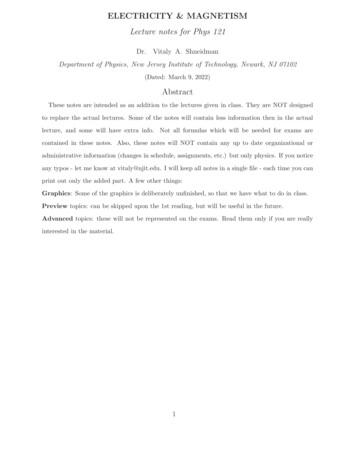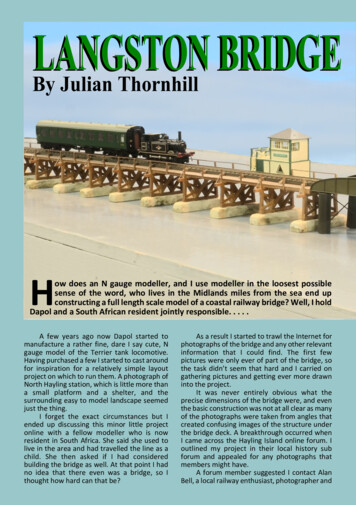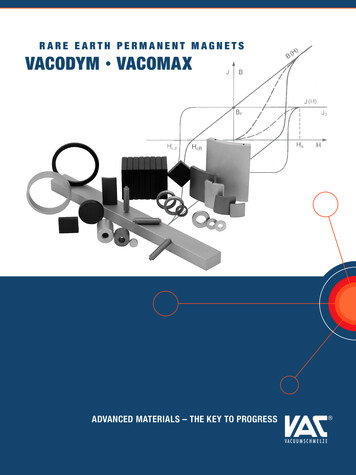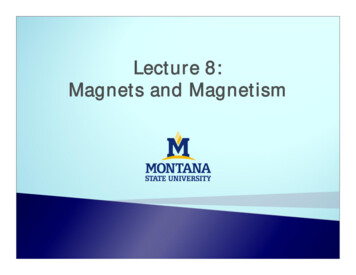
Transcription
Lecture 8:Magnets and Magnetism
Magnets Materials that attract othermetals Three classes: natural, artificialand electromagnets Permanent or Temporary CRITICAL to electric systems:– Generation of electricity– Operation of motors– Operation of relays
Magnets Laws of magnetic attraction and repulsion–Like magnetic poles repel each other–Unlike magnetic poles attract each other–Closer together, greater the force
Magnetic Fields and Forces Magnetic lines of force– Lines indicating magnetic field– Direction from N to S– Density indicates strength Magnetic field is region whereforce exists
Magnetic TheoriesMolecular theory ofmagnetismMagnets can be split intotwo magnets
Magnetic TheoriesMolecular theory ofmagnetismSplit down to molecularlevelWhen unmagnetized,randomness, fields cancelWhen magnetized, order,fields combine
Magnetic TheoriesElectron theory of magnetism Electrons spin as they orbit(similar to earth) Spin produces magnetic field Magnetic direction depends ondirection of rotation Non-magnets equalnumber of electrons spinningin opposite direction Magnets more spin one way than other
Electromagnetism Movement of electric chargeinduces magnetic field Strength of magnetic fieldincreases as current increasesand vice versa
Right Hand Rule (Conductor) Determines direction ofmagnetic field Imagine grasping conductorwith right hand Thumb in direction of currentflow (not electron flow) Fingers curl in the direction ofmagnetic fieldDO NOT USE LEFT HAND RULE IN BOOK
ExampleDraw magnetic field lines aroundconduction pathE (V)R
Another Example Draw magnetic field linesaround conductorsConductorcurrent into pageConductorcurrent out of page
Conductor coils Single conductor not very useful Multiple winds of a conductor required for mostapplications,– e.g. electromagnet, motors, solenoids Strength of magnetic field now dependent oncurrent magnitude and number of turns
Right Hand Rule (Coil) Imagine grasping coil with right hand Fingers in direction of current flow(not electron flow) Thumb points in direction of magneticfield through coilCreateselectromagnetDO NOT USE LEFT HAND RULE IN BOOK
Example Draw magnetic field lines through andaround coil
Magnetic Force on MovingCharge A magnetic field has a force on a moving charge Lorentz Force Law (don't need to know, just tellingyou)Two right hand rules.Choose which one is bestfor you.I like the one on the right.
ExampleDraw direction of force on conductorsNSNS
Another ExampleWhat about mutual force on conductors due toinduced magnetic fields?Force RepelsForce Attracts
Magnetic Circuits Magnetic Flux in circuit similar to current– Unit: Maxwells (Mx) 1 magnetic line of force. Magnetomotive Force (mmf) similar to voltage– Unit: Gilberts (Gb) the mmf that will establish aflux of 1 Mx in a magnetic circuit having areluctance (rel) of 1 unit.– In electromagnets mmf is proportional to coilcurrent and number of turns Reluctance (rel) is similar to resistance– Material's opposition to magnetic flux Permeance is similar to conductance– inverse of reluctance– Material's ability to conduct magnetic flux
Magnetic Circuits Permeability of air is low (high reluctance) Permeability of soft iron is high (lowreluctance)Majority of reluctance inair gap
Magnetic CircuitsAnalogouscircuitE (V)IR
DO NOT USE LEFT HAND RULE IN BOOK Creates electromagnet. Example Draw magnetic field lines through and around coil. Magnetic Force on Moving Charge A magnetic field has a force on a moving charge Lorentz Force Law (don't need to know, just telling you) Two right hand rules.




